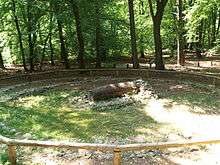Secondary burial


The secondary burial (German: Nachbestattung or Sekundärbestattung) is a feature of certain prehistoric grave sites of all types, identified since the New Stone Age, which is a frequent feature of megalithic tombs and tumuli. Secondary burials were also a mortuary custom among many Native American cultures.
Overview
From an archaeological and ethnographic perspective, the types of burial ceremonies for the dead are divided into two categories: primary burials and secondary burials. Primary burials refers to the initial burial, with temporary or final severance of all physical contact of family and community members with the deceased.[1] Secondary burials may (but do not always) occur after the primary ceremony. Any remains are the focus of the secondary ceremony. These remains are used to alter the spiritual condition of the deceased.[2]
Description
Artificial mounds and other, clearly visible, above-ground structures have been re-used since the New Stone Age (and even in later times, often by much later cultures) for burials of bodies, bones or cremated remains (in urns). These more recent burials, of whatever form, are referred to by archaeologists as secondary burials. They are found in grave mounds, usually in those areas of the site that could at the same time be extended. In larger dolmens, passage graves, stone cists, etc. the re-use of the interior space available was usually closer in time to the original burial (e.g. by the Globular Amphora culture), if necessary also accompanied by the removal or addition of secondary chambers (as in the Megalithic tombs of Hagestad). The mounds of the megalithic tombs, which were usually covered with earth, were re-used following a similar shape as the original grave mound.
Secondary burial in the Holy Land involved an initial interment in a tomb, for example, prone on a bench, until the body decayed. Subsequently, the decayed remains would be relegated to a nearby receptacle within the same tomb. Later, another person, typically a later member of the same family, would be placed on the same bench, and the process would continue. This practice is described in the article on Ketef Hinnom.
This practice of secondary burial should be distinguished from the continual use of natural caves, even when this falls during the same historical period, because they did not involve artificially constructed monuments.
Insights and Analysis
Much of the recordings of burial ceremonies were from the observations of explorers, missionaries, and administrative personnel who lived amongst native peoples.[2] In the late 19th and early 20th century. Three important figures in analyzing these accounts were Hertz, Schärer, and Stöher. These scholars characterized the secondary burials of the Ngadju-Daya communities. These communities were part of the Dayak culture in Indonesia, and had a very structured approach to secondary burial ceremonies.[2] These highly structured ceremonies helped the community feel as though they had some semblance of control over death.[1] The translation and interpretation of Hertz’ thesis was seminal in the field, and is still used as a basis for understanding and interpreting current cultural practices of secondary burial. The overarching theme for Hertz was that in the Ngadju-Daya communities there was a moral obligation from both the family and community to benefit the deceased in the afterlife.[2] In addition to providing for the deceased, this ceremony emphasized the greater good of the community over individualism.[1] However, it is important to note that neither Hertz, Schärer, or Stöher lived amongst these native people, leaving room for misinterpretation and bias.
Secondary burials are also seen in many cultures over the centuries outside of the Ngadja-Daya. The unique characteristics and frequency of secondary burials are often used to help identify and characterize past settlements.[1] These traditions have left a strong impression on people’s minds today, and hence have affected how we view past cultures in general. Some more well-known examples include the megaliths from the late Funnel Beaker culture, the stringent procedures in the single burial graves of the Battle Axe culture, and the uniqueness of the Pitted Ware Culture.[1] Some cultures even contain the remains of multiple individuals being subjected to fire, but defleshing as well.[1]
References
Further reading
Asa Larsson: Secondary Burial Practices in the Middle Neolithic-Causes and Consequences. Current Swedish Archaeology, Vol 11, 2003.